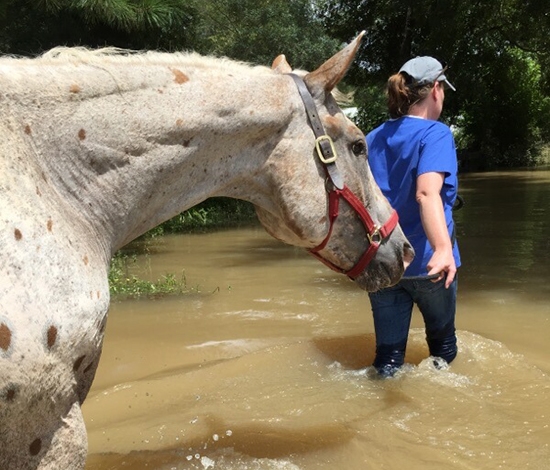Parishes brace for the worst as LA flood waters recede

Laura Riggs, BS, DVM, PhD, from LSU SVM rescues a horse in Livingston Parish.
As of today, the death toll in the Louisiana floods is 11; 20 parishes have been declared federal disaster areas, according to the Times-Picayune in New Orleans. As of Tuesday, The Louisiana Department of Wildlife and Fisheries had rescued a total of 598 animals, Adam Einck, a spokesman, told NEWStat.
But the worst is yet to come if you ask Rebecca McConnico, DVM, PhD, at the Louisiana State University School of Veterinary Medicine (LSU SVM).
“The water is going down so we’re starting to see lots of horses in pretty poor condition,” McConnico told NEWStat on Tuesday. “The parish closest to us is rural so there were a lot of animals. In Denim Springs, for instance, people were ready to go but the water came up to the roof so fast they didn’t have time to pack up the animals so they just let them go."
The slow moving storm dumped up to two feet of rain in East Baton Rouge, Livingston, and St. Helena parishes, in southeastern Lousiana over a few days, noted the Times-Picayune. The network of rivers that overflowed their banks only made it worse.
Luckily, LSU was spared any direct impact or loss of power. But the storm hit close to home in other ways. The parish next door to LSU was 90% decimated. Many students and staff, and their family members, were personally impacted; some lost everything.
"We do roll call during disasters," McConnico told NEWStat, "and learned that one of our equine surgeons, who lost his birds, was evacuating his own horses in chest deep water."
Thanks to Katrina, LSU has a disaster plan in place. The school acts as a key emergency center and keeps a list of who needs help and who has help to offer. It also partners with the Louisiana State Animal Response Team (LSART), whose volunteers are comprised mostly of veterinarians and their staffs, families, and clients.
AAHA accredited practice Highland Road Animal Hospital (HRAH) in Baton Rouge was spared as well, Carrie Fox, DVM and practice owner, told NEWStat. Despite half of the staff being directly affected--cars and houses flooded--HRAH operated normal business hours throughout the storm.
“I was at a shelter yesterday that allows people to shelter with their pets,” said Fox. “Lessons definitely were learned in Katrina. The shelter has about 2000 people and several hundred animals. It was amazingly calm in there, a few animals with health issues or heat stress.” Sick animals are triaged to local veterinary hospitals.
“Our hearts go out to the staff and community of Louisiana State University’s School of Veterinary Medicine that have been affected by the floods,” said Michael Cavanaugh, DVM, DABVP, chief executive officer of AAHA. “When a hospital within the AAHA community suffers, we all suffer. We hope that all of our practice team members and their pets and patients stay safe during this difficult time.”
The Humane Society of Louisiana in New Orleans is operating two facilities in the disaster areas, according to its website. The challenge is the lack of animal protection infrastructure in Louisiana.
“Many of the parishes in the disaster zone have no animal control agencies or shelters to house or help animals in need,” said Executive Director and founder, Jeff Dorson.
If you’d like to help, you can contribute to LSU SVM’s disaster relief efforts. Funds are used for equipment, personnel, supplies, communications, and patient care. Funds are also used for wildlife whose cases surge in a disaster and who are treated free of charge in the Veterinary Teaching Hospital.
Photo compliments of Louisiana State University School of Veterinary Medicine



